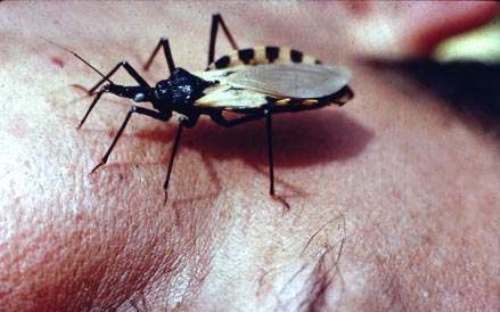Makindo Medical Notes"One small step for man, one large step for Makindo" |
|
|---|---|
| Download all this content in the Apps now Android App and Apple iPhone/Pad App | |
| MEDICAL DISCLAIMER: The contents are under continuing development and improvements and despite all efforts may contain errors of omission or fact. This is not to be used for the assessment, diagnosis, or management of patients. It should not be regarded as medical advice by healthcare workers or laypeople. It is for educational purposes only. Please adhere to your local protocols. Use the BNF for drug information. If you are unwell please seek urgent healthcare advice. If you do not accept this then please do not use the website. Makindo Ltd. |
American Trypanosomiasis (Chagas Disease)
-
| About | Anaesthetics and Critical Care | Anatomy | Biochemistry | Cardiology | Clinical Cases | CompSci | Crib | Dermatology | Differentials | Drugs | ENT | Electrocardiogram | Embryology | Emergency Medicine | Endocrinology | Ethics | Foundation Doctors | Gastroenterology | General Information | General Practice | Genetics | Geriatric Medicine | Guidelines | Haematology | Hepatology | Immunology | Infectious Diseases | Infographic | Investigations | Lists | Microbiology | Miscellaneous | Nephrology | Neuroanatomy | Neurology | Nutrition | OSCE | Obstetrics Gynaecology | Oncology | Ophthalmology | Oral Medicine and Dentistry | Paediatrics | Palliative | Pathology | Pharmacology | Physiology | Procedures | Psychiatry | Radiology | Respiratory | Resuscitation | Rheumatology | Statistics and Research | Stroke | Surgery | Toxicology | Trauma and Orthopaedics | Twitter | Urology
Related Subjects: |Fever in a traveller |Malaria Falciparum |Malaria Non Falciparum |Viral Haemorrhagic Fevers (VHF) |Lassa fever |Dengue |Marburg virus disease |AIDS HIV |Yellow fever |Ebola Virus |Leptospirosis |Crimean-Congo haemorrhagic fever |African Trypanosomiasis (Sleeping sickness) |American Trypanosomiasis (Chagas Disease) |Incubation Periods |Notifiable Diseases UK
🧑⚕️ Chagas disease was first described in 1909 by Carlos Chagas in Brazil. It is caused by the protozoan Trypanosoma cruzi, transmitted by the faeces of the triatomine (reduviid) bug.
📖 About
- 🌎 Endemic in South America, causing >50,000 deaths annually.
- 🦠 Caused by infection with T. cruzi.
🏚️ Triatomine bugs thrive in cracks of poorly built houses (mud, thatch, adobe). 🌙 They feed at night → people in endemic areas should avoid sleeping in such dwellings or outdoors.
🧬 Aetiology
- 🦟 Vector: reduviid “kissing bug”.
- Acquires parasite from infected host → transmits via faeces.
- Parasite enters through mucous membranes or skin breaks.
- Other routes: 💉 blood transfusion, 👶 vertical transmission.

🩺 Clinical Features
- ⚡ Acute phase: fever, rash, lymphadenopathy, hepatosplenomegaly, myalgia, myocarditis. • Chagoma: swelling at entry site. • Romana’s sign: periorbital oedema (classic).
- ⌛ Chronic phase: often silent for years → complications: ❤️ dilated cardiomyopathy, arrhythmias, cardiac arrest. 🍽️ Mega-oesophagus → dysphagia. 🚽 Megacolon → constipation, obstruction.
🔎 Investigations
- 🩸 Blood smear: parasites in acute phase.
- 🧪 Serology: IgG antibodies in chronic phase.
- 📈 FBC, U&E, ESR.
- 🫀 ECG, Echo: assess cardiomyopathy.
- 📷 Barium swallow/Endoscopy: GI involvement.
- 🖥️ CT/MRI if CNS involvement suspected.
💊 Management
- Antiparasitic: Benznidazole or Nifurtimox → best in acute/early chronic or reactivation (e.g. immunosuppression).
- ❤️ Cardiomyopathy: arrhythmia control, anticoagulation, heart failure therapy.
- 🍽️ Mega-oesophagus: dietary modification, balloon dilation.
- 🚽 Megacolon: fibre, fluids, enemas.
- Note: antiparasitic drugs do not reverse established organ damage.
🛡️ Prevention
- 🏠 Improve housing → reduce bug infestations.
- 🦟 Use bed nets, insecticide, repellents, protective clothing.
- 💉 Screen blood transfusions & organ donors.
- 🚫 Avoid contaminated food in endemic regions.
🧪 Screening for Blood Donors
- ❌ Exclude donors from South/Central America (including southern Mexico) unless seronegative after ≥6 months of no exposure.
🤰 Pregnancy
- Offer serology to at-risk women; refer positives to specialist centres.
- 👶 Infants born to seropositive mothers require follow-up for congenital infection.
💡 Exam tip: Think Chagas if you see Romana’s sign (eyelid swelling) in acute disease, or unexplained dilated cardiomyopathy in a South American patient.